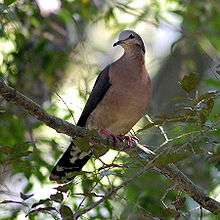Grey-fronted dove
The grey-fronted dove, (Leptotila rufaxilla) is a large New World tropical dove. It is a resident breeder in South America from Colombia, Venezuela and the Guyanas south to northeast Argentina and Uruguay. Several subspecies exist, among them L. r. hellmayrii from Trinidad and the Paria Peninsula in Venezuela.
| Grey-fronted dove | |
|---|---|
 | |
| Scientific classification | |
| Kingdom: | Animalia |
| Phylum: | Chordata |
| Class: | Aves |
| Order: | Columbiformes |
| Family: | Columbidae |
| Genus: | Leptotila |
| Species: | L. rufaxilla |
| Binomial name | |
| Leptotila rufaxilla (Richard & Bernard, 1792) | |
The grey-headed dove, Leptotila plumbeiceps, of Central America and the Grenada dove, L. wellsi, of Grenada were formerly considered conspecific with grey-fronted dove.
The grey-fronted dove inhabits humid forest and woodland. It builds a large stick nest in a bush or on a stump and lays two white eggs.
The grey-fronted dove is very similar to the closely related white-tipped dove, Leptotila verreauxi, which, in the area of overlap, prefers more open, drier, woodland.
It has an approximate length of 28 cm (11 in) and a weight of 155 g (5 1⁄2 oz). Adult have a blue-grey crown, a whitish forehead and a grey neck showing purple iridescence. They have a whitish throat and the eye-ring is red. The upperparts and wings are grey-brown, and the underparts are whitish shading to pinkish-buff on the chest. The underwing coverts are rufous. The white tip to the tail is narrower than in the white-tipped dove. The bill is black, the legs red and the iris is yellow. L. r. hellmayrii has a paler forehead and darker, more rufous, breast.
It is best distinguished from the white-tipped dove by the buffier lower face and the more contrasting, bluish-grey crown. Another feature is the red (not blue) eye-ring of the grey-fronted dove, but this is not reliable in all parts of Brazil, Argentina, Bolivia, Paraguay and Uruguay, where it typically is red in both.
The grey-fronted dove is usually seen singly or in pairs, and is rather wary. Its flight is fast and direct, with the regular beats and clattering of the wings which are characteristic of pigeons in general.
The food of this species is mainly seeds obtained by foraging on the ground, but it will also take insects. The call is a deep hollow ooo-wooooo-ou.
References
- BirdLife International (2012). "Leptotila rufaxilla". IUCN Red List of Threatened Species. 2012. Retrieved 26 November 2013.CS1 maint: ref=harv (link)
- Hilty, Steven L (2003). Birds of Venezuela. London: Christopher Helm. ISBN 0-7136-6418-5.
- ffrench, Richard (1991). A Guide to the Birds of Trinidad and Tobago (2nd ed.). Comstock Publishing. ISBN 0-8014-9792-2.
External links
- Grey-fronted dove videos on the Internet Bird Collection
- Stamps (for Suriname) with RangeMap
- "Gray-fronted dove" photo gallery VIREO Photo-High Res
- Photo-High Res; Article terrabrasil
- Photo-Medium Res; Article, Map & synopsis https://www.nhlstenden.com/;Doves in Suriname
